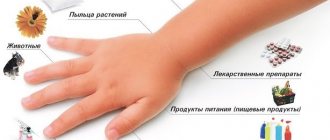General
Angioedema
- acutely developing, rapidly passing swelling of the skin and subcutaneous tissue or mucous membranes.
Code according to the international classification of diseases ICD-10:
- D84.1
- T78.3
Etiology.
Angioedema is a polyetiological disease that can be caused by both immune and non-immune factors.
. Allergic
— manifestation of an allergic reaction of type I;
develops as a manifestation of sensitization to drugs (usually antibiotics), food products and additives, and the venom of stinging insects (bees, wasps and hornets). . Pseudo-allergic
- as a result of the direct non-immune histamine-releasing action of certain drugs (salicylates and other NSAIDs, ACE inhibitors, dextrans, etc.), foods or additives (see Food allergy).
. Complement - dependent
- can be inherited or acquired (usually in patients with lymphoproliferative malignancies, which is associated with an acceleration of the metabolism of the C1 esterase inhibitor of the complement component by 2-3 times).
. Idiopathic
- etiology is unclear.
Causes
Risk factors
.
Atopic predisposition. Taking ACE inhibitors (in 0.2% of cases). Presumably taking omeprazole (a proton pump inhibitor) and sertraline (a selective serotonin reuptake inhibitor). Genetic aspects.
Hereditary angioedema (*106100, complement C1 esterase inhibitor deficiency, 11p11.2-q13, deletion of the C1NH gene in type 1, point mutation in type 2, ) is characterized by recurrent episodes of swelling of the skin, upper respiratory tract and gastrointestinal tract (up to to intestinal obstruction). . C1q is an inhibitor - a highly glycosylated serum protein synthesized in the liver and inhibits the proteolytic activity of the C1r and C1s subcomponents, thus preventing the activation of the C4 and C2 complement components. . Insufficiency of C1q inhibitor leads to uncontrolled activation of early complement components and the formation of kinin-like factor, which causes an increase in vascular permeability and leads to the development of angioedema. . Most often (in 80-85% of cases) the cause of hereditary angioedema is a quantitative deficiency of the C1q inhibitor (type 1); in other cases, with a normal amount of inhibitor, the cause of hereditary angioedema is its functional inferiority of the C1 inactivator due to a point mutation in the reactive center of the molecule (type 2).
Pathogenesis
is similar to the pathogenesis of urticaria and is associated with dilatation and increased permeability of blood vessels (mainly venules) of the deep (unlike urticaria) layers of the dermis and submucosal layer, caused by allergic mediators (histamine, Pg, leukotrienes), as well as complement components (primarily C3a and C5a ) and kinins.
Pathomorphology.
Edema, vasculitis and/or perivasculitis involving only subcutaneous tissues.
Clinical picture
. Local swelling of the skin, subcutaneous tissue and/or mucous membranes, with or without urticaria. Often - an integral component of a generalized anaphylactic reaction (anaphylactic shock). Can develop anywhere on the body; The usual localization is the face (usually lips, eyelids), limbs, external genitalia. The greatest danger to life is edema of the larynx and the asphyxia caused by it. Fast onset and rapid spontaneous resolution. Characterized by a feeling of numbness and itching, which is much less pronounced compared to urticaria.
Forecast
The result of Quincke's edema depends on the severity of the manifestations and the timeliness of therapeutic measures. Therefore, swelling of the larynx without emergency help ends in death. Recurrent urticaria in combination with angioedema, which persists for six months or more, is observed in 40% of patients over the next 10 years, and in 50% long-term remission can be observed even without maintenance therapy. Hereditary angioedema occurs regularly throughout life. Properly selected supportive treatment avoids complications and significantly improves the quality of life of patients with Quincke's edema.
Diagnostics
Laboratory research
. In the allergic form - determination of IgE using a radioallergosorbent test (primarily for allergies to penicillin, as well as food allergens). Determination of the levels of C1q - inhibitor, as well as C2 and C4 complement components in hereditary angioedema.. Decrease in the level of C1q - inhibitor below 100 mg/ml in type 1.. Decrease in C4 in both types 1 and 2.. C2 is reduced during exacerbation. for types 1 and 2 .. In patients with acquired forms of C1 inactivator deficiency, C1 is also reduced (unlike congenital forms).
Differential diagnosis
. Diffuse subcutaneous infiltrative process. Contact dermatitis. Lymphostasis (lymphatic edema). Thrombophlebitis. Local edema in somatic pathology. Granulomatous cheilitis. Erysipelas with severe swelling. Cellulite.
Treatment
TREATMENT
Diet
.
Elimination of known food allergens (egg whites, milk and wheat, fish, nuts, tomatoes, chocolate, bananas, citrus fruits) up to the transition to a basic hypoallergenic diet. Lead tactics
.
Protection from exposure to known triggers. Cold compress to reduce the intensity of itching. Intubation for upper airway obstruction. Drug therapy
. Drugs of choice - see Urticaria. Extra caution! Angioedema of the larynx and the asphyxia caused by it are potentially life-threatening and require active therapy. Epinephrine 0.3 ml 0.1% r - pa subcutaneously, as well as locally in the form of an aerosol. GK - dexamethasone 4-8 mg IM or IV, or 30-60 mg prednisolone; in hereditary angioedema, the effectiveness of GC is questionable. Antihistamines - dimethindene IV, diphenhydramine, clemastine IM 1-2 ml.
Complications
.
Asphyxia caused by airway obstruction. Current and prognosis
. Most patients with angioedema have little general impairment, except in cases of airway obstruction. In chronic forms, the course and prognosis depend on the etiology and pathogenesis.
Concomitant pathology
.
Anaphylaxis. Hives. Prevention
. Avoid contact with the causative factor. ACE inhibitors are contraindicated. Before performing procedures that can provoke the development of hereditary angioedema (dental interventions, intubation, endoscopy, etc.), danazol 200 mg 3 times a day is recommended 3 days before the procedure, and immediately before it - the administration of 2 standard packages of fresh frozen plasma. For long-term prevention: .. Danazol 200-600 mg daily for 1 month, then every 5 days for 5 days. Danazol is ineffective in other forms of C1 esterase inhibitor deficiency; Contraindicated for children, pregnant women, nursing mothers, and for porphyria; may cause headache, weight gain, hematuria.. Aminocaproic acid 1 g 3 times a day.
Synonyms
. Quincke's disease. Quincke's edema.
ICD-10. T78.3 Angioedema. D84.1 Defect in the system
The direct cause of the development of hereditary angioedema is primary immunodeficiency, which consists of a deficiency or functional inferiority of the esterase inhibitor of one of the complement components - C1. As a result, the inhibition of the activation of other components of this system - C4 and C2 - is also disrupted, which leads to even greater disruption of the functioning of this immune mechanism. Geneticists have been able to identify the gene responsible for 98% of forms of hereditary angioedema - it is C1NH, located on chromosome 11 and encoding the above-mentioned C1 esterase inhibitor. Various mutations can lead to forms of the disease that are different in their course, which have fairly similar clinical manifestations, but differ when conducting a number of diagnostic tests. With some types of mutation of the C1NH gene, a complete cessation of the synthesis of the C1 inhibitor protein occurs, as a result of which it is absent from the blood plasma, and the complement system is stopped by ineffective side pathways. In other cases, hereditary angioedema occurs against the background of normal levels of the inhibitor in the blood, while the genetic defect C1NH leads to a disruption of the structure of the active center of this enzyme. As a result, the C1 inhibitor becomes functionally inferior, which is the cause of the development of pathology. There are also rare forms of hereditary angioedema, in which there are no changes in the amount or activity of the C1 esterase inhibitor, or mutations in the C1NH gene - the etiology and pathogenesis of such diseases is currently unknown. Stopping the inhibition of the activity of complement components (C1, C2, C4) leads to the launch of an immune reaction, similar in its course to an allergic reaction, especially urticaria. Complement components are able to expand the blood vessels of the deep layers of the dermis, increase the permeability of their walls, which provokes the diffusion of blood plasma components into the intercellular space of the skin tissues and mucous membranes and leads to their swelling. In addition, an important role in the pathogenesis of hereditary angioedema is played by vasoactive polypeptides - bradykinin and kallikrein, which further increase the degree of edema and are also capable of causing spasm of the smooth muscles of the gastrointestinal tract. These processes cause a wide variety of symptoms of hereditary angioedema: swelling of the skin (in the area of the extremities, face, neck) and mucous membranes (oral cavity, larynx, pharynx), abdominal pain and dyspeptic disorders provoked by a combination of edema and spasms.
Angioedema is a dangerous disease that can be fatal. Allergic angioedema affects large areas of skin, connective tissue, and muscles. The development mechanism is based on the release of plasma into the intercellular tissue due to increased vascular permeability. When it occurs in the larynx, emergency assistance is required, as a person may die from suffocation. It is observed mainly in children and women, but no one, regardless of gender and age, is immune from developing the disease.
ICD 10 code places angioedema in class XII, subsection “Urticaria”. Pathology is classified as diseases of the skin and fat layer. The predisposition to violent reactions to stimuli may be innate. The cause of its occurrence is based on an instant-type allergy. High vascular permeability is explained by the release of irritation mediators from sensitized (sensitive) tissue basophils.
The causes of giant urticaria are as follows:
- Pollen.
- Dust (household).
- A bite of an insect.
- Food allergens. Exotic fish, marinades, dried fruits, sausages, sausage, chocolate, strawberries. In children under three years of age, allergies are caused by foods that are harmless to older ones.
- Smells of washing powders, perfumes, etc.
- Medicines - penicillin antibiotics, salicylates, anticonvulsants, iodates, hyperimmune serums, steroids.
- Dyes, preservatives.
- Animal fur.
- Cold.
- Sun.
Features of angioedema, ICD 10 code, symptoms, treatment of pathology
Angioedema is an allergic manifestation of the body's immune system in the form of swelling of the skin, fatty tissue and mucous membranes. The pathology is distinguished by an acute onset, unpredictable course and completion.
Sometimes this reaction of the body ends in death.
Therefore, in order to be able to help in a timely manner, you need to know: angioedema - what it is, about the manifestations of the pathology, how to provide first aid for angioedema.
What is angioedema?
This pathology is often called angioedema, named after the doctor who first described it. Among doctors, the pathology is also called giant urticaria, and sometimes allergic acute edema.
Angioedema - what is it? Angioedema is an allergic reaction to an irritant (allergen). More often it affects the face and pharynx, but sometimes it also affects internal tissues, even the meninges. No one is immune from the danger of developing such a pathology. Therefore, everyone needs to know about it.
I swell all the time. Angioedema
Edema develops when an allergen enters the body. Under its influence, vascular permeability increases. From them, blood plasma enters neighboring tissues. As a result, most often the upper part of the body swells greatly.
Various reasons provoke such a reaction:
- animal hair;
- plants;
- dust on the street or inside the apartment;
- various household chemicals;
- low-quality or expired cosmetics;
- food products;
- stress;
- insect bites;
- medications.
Among the drugs that cause such a reaction, a special place stands out: aspirin, penicillin and its analogues, bromide.
Kinds
Classification of angioedema:
- Allergic . It is dangerous because the symptoms develop suddenly, are unpredictable, and cannot be prevented.
- Hereditary angioedema. This type of pathology is rare. Provocation by allergens is not required for its appearance. Seizures occur spontaneously in the absence/deficiency of inhibitors of enzymes of the complement-dependent system in the blood. The danger is that the larynx swells, and this leads to suffocation.
Additional species, the mechanism of which is poorly understood:
- Vibrating. Occupational pathology that appears some time after exposure to vibration.
- After physical activity . It occurs after physical exercise, which is sometimes associated with the work of the autonomic system.
- From squeezing . Swelling occurs with increased load on the tissues of certain parts of the body.
- Reaction to cold . It manifests itself as damage to open areas of the body under the influence of low air or water temperatures.
Hereditary form (HAE)
This is a special genetic type of edema. The cause is the inheritance of gene mutations. HAE occurs due to a lack or unpredictable action of C1, an inhibitor of certain enzymatic reactions in the body. Attacks occur at any time, causing suffocation. HAE occurs when the immune response of a group of proteins in the complement system does not function properly in the body.
This type of edema is also called idiopathic. An attack can be caused by stress, a lack or excess of hormones, or microtrauma.
Hereditary angioedema. Glad. Biysk, Russia.
Angioedema is indicated in the unified plan for diagnostics and treatment of the international classifier among the adverse effects with the designation T78.x.
So T78.3 is precisely angioedema - code according to ICD 10, T78.0 is anaphylactic shock. Other numbers after the dot also characterize similar pathologies, such as allergic reactions.
Symptoms of angioedema
Angioedema symptoms vary depending on the type and causes that cause it. More often, the attack develops acutely, within a couple of minutes. Rarely does it grow for 2–4 hours. Swelling is usually localized on the face, often on the eyelids. The type of pathology is determined precisely by the location. So, with swelling of the submucosal tissues of the gastrointestinal tract, the patient develops:
- pain in the peritoneum;
- nausea with vomiting;
- disturbances in the process of defecation.
If the larynx swells, the patient typically breathes convulsively, deviations in the correctness of speech, and hoarseness are noticeable.
Sometimes swelling of other organs is observed:
- pleura;
- lower organs, urine excretory system;
- brain, tissues around;
- joints;
- muscle tissue.
In half of the patients, the disease is accompanied by urticaria and anaphylactic shock.
HAE first manifests itself before the age of twenty and is inherited. It grows slowly, the tissues return to normal in more than a week. More often it manifests itself as swelling of the nasopharynx or gastrointestinal tract. This type often recurs, occurring several times a year for various reasons, ranging from stress to microtrauma.
General clinical picture
Symptoms:
- At the beginning of development, the patient feels a lack of air and hoarseness occurs.
- With the development of pathology, local swelling of the skin, tissue underneath or mucous membrane is formed, combined with urticaria.
- Swelling is often accompanied by anaphylactic shock.
- It can develop on any organ, although it is more often localized on the face, limbs, external genitalia, for example, in the scrotum in men.
- The most dangerous is swelling of the larynx, which results in suffocation.
- The stage of asphyxia quickly sets in.
Swelling of the face, eyelids, larynx
Angioneurotic pathology or Quincke's edema is the body's response to allergens, accompanied by swelling of the face, eyelids so that it is difficult to open the eyes, and the laryngeal mucosa. The most common irritants:
- fungal spores;
- plant pollen;
- products;
- household substances;
- medicines, drugs;
- alcohol;
- insect and parasite bites;
- ultra-violet rays.
There are other allergens, but they are rare. Manifestations: swelling of the eyelids, face, oropharynx and nasopharynx.
Symptoms of swelling of internal organs
In addition to visible external swelling, allergic swelling inside the body often develops, which makes diagnosis difficult. Swelling of an internal organ is said to be:
- paroxysmal severe pain in the peritoneum;
- development of a lump or tumor on the chest, creating pressure on the chest;
- simultaneous appearance of vomiting and diarrhea.
Signs of cerebral edema
Sometimes doctors have to deal with cerebral edema, manifested by the following symptoms:
- muscle rigidity at the back of the head (characterized by the fact that the patient cannot touch the chin to the body);
- lethargy;
- lethargy;
- nausea accompanied by vomiting;
- frequent muscle cramps.
Diagnosis of angioedema
Attention! It is unacceptable to start treatment just like that. It is necessary to conduct a complete diagnostic examination, and as quickly as possible.
But it’s not always clear where to go for diagnosis.
Which doctor should I contact?
If you suspect a pathology, you need to call an ambulance, because swelling often develops in an unpredictable way. If you go to the hospital faster, the primary examination is carried out by a therapist. In the future, consultation with an allergist is necessary.
Types of examinations
When diagnosing, the doctor:
- analyzes the symptoms, the patient’s condition, studies the medical history (frequency of attacks, if this is not the first time, where they are located, whether the history contains signs of difficulty breathing, etc.);
- carries out pulse measurement (frequency, uniformity), measures blood pressure;
- examines the skin, looks for areas of edema.
After the swelling subsides, tests are performed to determine the cause of the allergy.
Necessary tests
In case of angioedema, blood is taken for a general detailed biochemical analysis and for immunoglobulin E in the blood.
How to treat angioedema?
In the acute form of the disease, treatment is aimed at eliminating the allergen that caused the attack. It must be done immediately. This eliminates the allergen that caused the swelling. If necessary, a tube is inserted into the throat to allow the patient to breathe.
First aid
Knowing how to provide first aid for swelling can save a person’s life. When the first signs of impaired breathing or the development of visible swelling appear, immediately call an ambulance.
Before her arrival, you can only try to remove the allergen and reduce the swelling by applying ice to the site of development. If breathing is impaired, the patient’s neck is freed from obstructive clothing, soothed, and a flow of fresh air is provided.
The patient is placed half-sitting or sitting and given a drink.
If swelling develops in the nasopharynx, vasoconstrictor drops can be instilled into the nose. Give one of the antihistamines, if available (Suprastin or Venistil), or a sorbent (Atoxil).
Drug treatment
H2 blockers are prescribed during treatment. In severe cases, prednisolone is administered once a day (up to 40 mg). For swelling of the larynx, ephedrine is administered subcutaneously. Treatment is sometimes supplemented with antihistamines (for example, Diphenhydramine), diuretics (Furosemide). Eufillin is used to relieve bronchospasm.
If the blood pressure increases, the patient is given adrenaline.
Non-allergic angioedema requires slightly different treatment. In this case, therapeutic actions are carried out:
- give a blood transfusion;
- give Z-aminocaproic acid;
- Corticap is used.
H1 blockers are used after an acute attack has ended, for long-term treatment in the dosage forms that are available. Dosages of medications are indicated in the instructions for the medications. In addition, they take antihistamines, drugs that strengthen the nervous system, and vitamins.
Quincke's edema. Treatment of Quincke's edema. Clinic and diagnosis of Quincke's edema.
Surgeon intervention is required if there is severe swelling of the larynx. With this development of the disease, the doctor performs a tracheotomy to allow the patient to breathe.
Prevention
Patients who have had attacks in the past are prescribed ATP inhibitors (Enalapril, Ramipril) and receptor antagonists (Telmisartan, etc.).
Patients with severe reactions to foods need to follow a special diet. Those foods that can cause a reaction are excluded from the menu.
It is also necessary to avoid heavy stress, both nervous and physical, as well as hypothermia.
Women who have had AO should not use oral contraceptives.
All patients should avoid the use of activators (Altepase and similar drugs).
This disease is very dangerous and the outcome is sometimes fatal. Therefore, you do not need to rely on yourself and try to treat yourself. Timely consultation with a doctor, subsequent treatment and prevention will help prevent the onset of angioedema.
Source: https://allergolog.guru/zabolevaniya/angionevroticheskij-otek.html
Development mechanism
An acute allergic reaction is the result of three mechanisms: allergenic, non-allergenic, combined type:
- With the allergenic mechanism, an allergen—food, medicine, pollen—invades for the first time, the body perceives it as an antigen and produces antibodies. There is an increased sensitivity to the effects of irritants. Reintroduction of the allergen destroys the cell containing the antibodies. Histamine is released and swelling develops.
- In a non-allergenic mechanism, histamine is released in response to insect venom, medication, food or olfactory stimulus.
- Congenital angioedema is a combined form. Complement proteins are present in the blood in an inactive state. A stressful situation can serve as an activator. Complements mistake host cells for antigens. Swelling occurs.
Why do swelling appear on the body?
Edema is the result of an increase in pressure in the interstitial fluid and a sharp significant increase in the distensibility of the interstitial space.
Another reason for this unpleasant phenomenon is an increase in hydrostatic pressure in the capillary, leading to an increase in the permeability of the capillary wall.
Before swelling caused by disruptions in the functioning of the filtering organ begins to “appear,” the following is observed:
- increase in intracapillary pressure;
- increased filtration of fluid in tissues, decreased reabsorption;
- decrease in the amount of plasma proteins;
- failure in the well-functioning process of removing water from the intercellular space;
- increasing capillary permeability;
- violation of the excretory system of the kidneys;
- violation of water-salt metabolism;
- An increase in the secretion of the hormone aldosterone causes retention of sodium and water ions.
Symptoms of manifestation
Urticaria and angioedema are observed on surfaces underlying loose fatty tissue. These are lips, cheeks, eyelids, oral mucous membranes, and scrotal skin. The code is ICD 10; it does not establish the cause of the direct occurrence of edema. Reactions develop to different allergens. The number of factors that can cause an inadequate response of the body is constantly increasing.
Symptoms of angioedema last for several hours or days, and treatment is required immediately. Often, hives go away on their own. It is characterized by a violent beginning and rapid continuation.
Symptoms of angioedema:
- Angioedema of the larynx is characterized by hoarseness, difficulty breathing, and cough. The patient's anxious mood is noted. The skin of the face first takes on a bluish, then pale tint. Loss of consciousness is possible. Lack of treatment is fraught with death.
- Local swelling of different parts of the face. Lips, cheeks, eyelids become swollen. My eyes are watering.
- Swelling of the tonsils, palate, tongue.
- Swelling of the genitourinary formations. A painful state of urinary retention. Such symptoms, especially in children, are accompanied by excruciating pain in the lower abdomen.
- Brain swelling. Characterized by neurotic disorders and seizures.
- Moisture retention in the digestive organs. "Acute belly." Dyspepsia. Peritonitis.
Symptoms in adults are similar to those in children. But, the main cause of giant urticaria is taking medications.
Diagnostic methods
The diagnosis is made based on the clinical picture and medical history records. Of particular importance is information about the tolerability of medications when preparing for surgery or treating diseases.
The doctor is guided by the medical history:
- the presence of allergies in relatives, in the patient, seasonality of manifestation, presence of animals in the house;
- whether relatives suffered from allergies; did not react to vaccinations. Have you had allergies before? If so, what is its seasonality?
In the acute phase, laboratory diagnostics are carried out:
- During the weakening period, intradermal tests are carried out with 12-13 types of allergens.
- Redness of the insertion site is considered a positive result. The presence and intensity of the reaction indicates four possible results: negative, doubtful, weakly positive, positive.
Contraindications to tests:
- Exacerbation of indolent infections.
- Hormone therapy.
- Age>60.
Description
Crohn's disease in children is often called terminal ileitis, because it is the location of the foci of inflammation that is most characteristic of this disease.
The frequency of occurrence in the population does not exceed 0.1%. Most often diagnosed during puberty. The importance of Crohn's disease in pediatrics is very great. This is due to the chronic course of the pathology, which is why all therapy is palliative. In addition, at present the causes of the disease remain unclear, so preventative measures are not possible. The quality and life expectancy are significantly reduced, and Crohn's disease in children contributes to the structure of child mortality and disability.
Types of treatment
Signs of urticaria and angioedema oblige the doctor to make immediate decisions. If laryngeal edema is detected, potent antiallergic medications are immediately administered, for example, calcium gluconate or chloride, intravenously; a “hot injection” helps relieve angioedema. The patient is hospitalized in the intensive care unit or intensive care unit.
Therapeutic measures are carried out in two stages: elimination of the acute phase, destruction of the cause of the disease. The choice of how to treat an allergic manifestation is determined by the severity of the swelling.
If anaphylaxis develops, the patient is referred to resuscitation specialists, laryngeal edema - ENT. Abdominal symptom complex sends to surgeons. If there is no threat to life, they are sent to allergists or therapists.
Use of prednisolone
Prednisolone is a systemic corticoid with anti-inflammatory and anti-edematous effects. It is used as first aid for angioedema.
The antiallergic effect of prednisolone is manifested in the following:
- Immunosuppressive effect - destruction of antibodies, blocking cell growth and specialization.
- Prevention of granule loss by tissue basophils.
- Inhibition of the synthesis of allergic reaction mediators
- Reduced vascular permeability. The swelling decreases, the pressure increases, the lumen of the bronchi expands.
Prednisolone is administered intravenously according to the instructions.
What to do if the allergy does not go away?
You suffer from sneezing, coughing, itching, rashes and redness of the skin, and maybe your allergies are even more serious. And isolating the allergen is unpleasant or completely impossible.
In addition, allergies lead to diseases such as asthma, urticaria, and dermatitis. And for some reason the recommended medications are not effective in your case and do not combat the cause in any way...
We recommend reading in our blogs the story of Anna Kuznetsova, how she got rid of allergies when doctors gave her a hard time. Read the article >>
Author: Polina Zinkovskaya
What to do to relieve angioedema at home.
Medicines for Quincke's edema and a description of their action.
How and why swelling appears in the eyes.
Diet, nutrition and recommendations for Quincke's edema.
Comments, feedback and discussions
Finogenova Angelina: “In 2 weeks I completely cured my allergies and got a fluffy cat without expensive drugs and procedures. It was simple enough. » More>>
Our readers recommend
For the prevention and treatment of allergic diseases, our readers advise using the “ Alergyx ” product. Unlike other products, Alergyx shows lasting and stable results. Already on the 5th day of use, allergy symptoms decrease, and after 1 course it goes away completely. The product can be used both for prevention and for relieving acute manifestations.
Quincke's edema is one of the variants of allergic diseases, which is characterized by the rapid development of pathological symptoms due to increased reactivity of the body.
Prevention of giant urticaria
Prevention is ensured by following a diet, eliminating contact with irritants, treating chronic ailments, and constantly using antihistamines.
Quincke's edema is swelling that rapidly arises and develops on the mucous membranes and subcutaneous fatty tissue. Based on the information provided on Wikipedia, this condition was first described in 1882 by the German physician Heinrich Quincke. Angioedema and giant urticaria are alternative names for angioedema.
Heinrich Quincke also discovered such a phenomenon as Quincke's pulse - the nail capillary pulse. It represents a rhythmic change in the color of the nail bed. The pulsation coincides with the rhythm of the arterial pulse. Capillary pulse of the nail is considered a sign of aortic valve insufficiency.
In the International Classification of Diseases, 10th revision (ICD-10), angioedema is included in the heading “Adverse effects not elsewhere classified” with ICD code T78. All adverse effects that occurred after surgical and therapeutic interventions are excluded from this section of ICD-10. In ICD-10, Quincke's edema is coded T78.3. However, serum edema is excluded from this item in ICD-10.
Manifestation of the disease
Angioedema develops rapidly, and this is its danger to humans. Edema affects those organs and parts of the human body that have subcutaneous fatty tissue. This syndrome mainly affects children and young adult women.
Typical symptoms of angioedema:
- Laryngeal stenosis: A person experiences wheezing, a sore throat, difficulty breathing, and a dry, barking cough. Against this background, the person’s face turns blue and then turns pale. If the respiratory system is damaged, the risk of asphyxia (suffocation) increases, which, if help is not provided in time, can lead to death.
- Quincke's edema affects different parts of the face, mainly the eyelids, upper lip and cheeks.
- Damage to the mucous membranes of the oral cavity (tonsils, soft palate, tongue).
- Allergic reaction from the organs of the genitourinary system: women experience manifestations of acute cystitis, and men experience swelling of the scrotum.
- Angioedema can affect the abdominal organs, causing a person to experience acute abdominal pain, vomiting, nausea and bowel dysfunction.
A dangerous complication of this reaction is swelling of the membranes of the brain. In this case, a person develops symptoms such as severe headache, vomiting, stiff neck muscles and convulsions. This complication occurs more often in adults than in children.
As for the edema itself, it is localized in a specific area of the person’s face (body), or changes its location over time. Quincke's edema is a dense formation on the skin that remains elastic even with pressure. Often this is combined with urticaria, so a symptom appears such as purple spots on the skin, which cause pain and itching to a person. Fever and joint pain may also occur.
Depending on the symptoms, angioedema can be classified as:
- acute - lasts up to 6 weeks;
- chronic - over 6 weeks;
- hereditary;
- acquired;
- associated with urticaria;
- independent of any other syndrome.
It should be noted that a person who experiences manifestations of such a reaction needs emergency help:
- The patient is seated comfortably and reassured. It is recommended to remove tight clothing from the victim and ventilate the room.
- If possible, protect the person from further exposure to the allergen.
- Give the patient the antihistamine Claritin, Zyrtec, Fenistil or another. If symptoms from the digestive system occur, the tablet is replaced with an injection.
- Organize frequent and abundant drinking. You can add soda to the water (1 teaspoon per liter of liquid) or give the patient mineral water of medium mineralization.
- Give a person an enterosorbent drug, for example, activated carbon.
- To eliminate itching and swelling, apply a cold compress or ice to the affected area.
If manifestations of pathology in the respiratory system and brain occur, the patient diagnosed with Quincke's edema is hospitalized in the intensive care unit of the hospital.
Actions of the patient and the doctor
The patient needs diet and medications. For a quick recovery, treatment of a patient with edematous syndrome should be carried out under the watchful supervision of a doctor.
The doctor prescribes to the patient:
- salt-free diet: less salt, more foods with protein - vegetables, lean meat, lean fish, chicken breast, turkey;
- diuretics that remove fluid that has become unnecessary for the body;
- medications to support the heart: Asparkam, Panangin.
Advice from the people
To remove excessively accumulated fluid from the body, you can use folk remedies:
- A decoction of tender birch buds, prickly juniper fruits, medicinal lingonberry and bearberry leaves . Everything is taken in equal quantities: a tablespoon of the useful collection is poured with boiling water and cooked over low heat for 15 minutes. Then it needs to be cooled and filtered thoroughly. The patient should take 2 tablespoons daily five times a day.
- Dandelion leaf tea . Sold in a pharmacy, take a glass three times a day.
Diagnosis, treatment and nutrition
Diagnosis of the syndrome includes:
- Studying the patient's medical history (the doctor clarifies whether the patient has had similar reactions in the past, what allergens he has been in contact with recently, what drugs he has been treated with, etc.).
- Blood and urine analysis.
- Blood test for allergens.
- Fecal analysis for helminths.
- Studies aimed at excluding diseases that provoke edema.
Quincke's edema requires complex treatment aimed at eliminating the symptoms of the syndrome, preventing further development of the condition, as well as desensitizing the body (reducing sensitivity to the allergen). To stop the effect of the allergen on the body, cold compresses are used. However, if angioedema has developed due to an insect bite or drug injection, a tourniquet is applied above the skin puncture site.
To normalize breathing and eliminate swelling, treatment is carried out with Prednisolone, a universal drug that has antihistamine, decongestant and anti-inflammatory effects. Prednisolone is a systemic glucocorticoid that has an immunosuppressive effect, inhibits the secretion of mediators and reduces vascular permeability. Prednisolone is administered intravenously. Contraindications to the administration of Prednisolone are:
- third degree hypertension;
- stomach or duodenal ulcer;
- renal failure.
If swelling is combined with urticaria, Prednisolone is prescribed together with Dexamethasone.
Desensitizing treatment includes intramuscular injections of Tavegil or another antihistamine.
When answering the question of how to treat angioedema, one should take into account the symptomatic treatment of the disease, which helps to improve the patient’s well-being. So:
- To prevent hypotension, the patient is administered saline and colloidal solutions.
- Atropine injections are prescribed for bradycardia.
- For bronchial obstruction, inhaled bronchodilators are prescribed.
- Oxygen treatment is prescribed for cyanosis and dyspnea.
If the swelling has developed for non-allergic reasons, the treatment tactics will be different, depending on the disease that provoked the syndrome. The most difficult task is the treatment of hereditary angioedema. A person with this disease requires a plasma transfusion, as well as the administration of aminocaproic and tranexamic acid. If the face and neck are swollen, treatment with the diuretic drug Furosemide and Dexamethasone is indicated.
Diet for Quincke's edema is an integral part of therapy. First of all, potentially allergenic foods are excluded from the patient's diet and replaced with those that cannot cause allergies. Preference is given to nutritious food rich in vitamins and microelements.
The diet for Quincke's edema excludes the use of:
- nuts;
- citrus fruits;
- milk;
- cocoa and chocolate;
- tomatoes;
- sea fish and shellfish;
- lentils, peas, beans;
- products with preservatives, dyes and flavors.
What conditions lead to edema?
Most often, edema is caused by allergies, abnormalities in the structure of the kidneys, infections, intoxications, and tumor processes in the filtering organ.
Edema syndrome may indicate the presence of the following diseases in the patient:
- jade;
- renal failure;
- nephrosis;
- vasculitis;
- amyloidosis;
- glomerulonephritis;
- renal vein thrombosis;
- diabetes mellitus;
- systemic lupus erythematosus;
- syphilis;
- acute poisoning with alcohol or drugs.
Prevention
Limiting contact with allergens and timely treatment of diseases that can provoke such a reaction will help prevent the occurrence of giant urticaria. Adults need to follow safety rules when working with chemicals. If a person suffers from allergies, he should always have an antihistamine with him.
The human body is an unusually complex interweaving of various “parts”, mechanisms and systems that are very closely interconnected. At the same time, each person has his own characteristics, we react differently to various pathogens, products, and so on, which is why it is quite difficult to predict the reaction to some medicine or new product.
There is always a risk that the body will react incorrectly; there is a possibility that angioedema will occur, for which first aid is necessary.
Quincke's edema is also called angioedema or giant urticaria, all of which are synonyms. This disease has also been assigned an international code - ICD 10, by which this type of urticaria is recognized by any doctor around the world. Now we will talk about the causes of angioedema, consider the symptoms, classification of the disease and first aid methods.
First aid
First aid for Quincke's edema according to the ICD can save a person's life. Therefore, you need to do the following:
- call emergency medical assistance;
- lay the patient horizontally;
- if possible, eliminate contact with the allergen;
- ensure the flow of fresh air into the room;
- unfasten the patient's belt and buttons;
- to remove allergens, give Enterosgel or activated carbon tablets;
- provide drinking plain clean or alkaline water;
- give an antihistamine;
- create peace for the patient.
In severe cases, you need to be in touch with emergency doctors and follow all instructions before their arrival. You can use any antiallergic medications. These are Citrine, L-cet, Fenkarol, Suprastin, Claritin and others. The drug Alergonix is effective.
An adult with allergies should carry antihistamines prescribed by a doctor with him at all times. If a child has a pathology, it is necessary to ensure that relatives and friends in kindergarten and school know about it and can provide first aid. This will help cope with the disease - Quincke's edema and prevent serious consequences.
Causes and types of disease
Quincke's edema, often referred to by the designation ICD 10, is a disease or allergic reaction of the body to an external pathogen. When it appears, very severe swelling is observed, which affects the skin, subcutaneous epithelium and fiber. Externally, this reaction is observed as a strong increase in the size of the skin in certain areas of the body.
Regarding the latter, giant urticaria usually appears in the neck, face, extremities of the arms and legs, as well as the torso. Fortunately, the membranes of the brain, internal organs and joints fall into this risk zone extremely rarely, but still the disease is very dangerous and you need to clearly understand how first aid is provided for Quincke's edema.
It is also very important to understand that Quincke's edema is divided into two types, differing in the specifics of their occurrence.
Allergic - the body's reaction to contact with an allergen. It could be anything, a food product, a drug, a chemical, etc.
Pseudoallergic - occurs as a congenital abnormality in the complement system, a complex of complex proteins present in the blood of every person. In standard cases, these proteins can only cause swelling if an antigen enters the body, but if a person was born with the anomaly in question, an allergic reaction may well occur spontaneously, which is very dangerous.
Angioedema has a certain gradation of occurrence.
Thus, in the majority of cases, such a reaction of the body was most often recorded in people susceptible to various allergic reactions. It is also worth noting that women under 30 years of age and children suffer from urticaria more often than men of the same age and older people.
Why is angioedema a subtype of urticaria?
For angioedema of any etiology, the ICD code is always the same. Pathology is considered one of the severe manifestations of an immediate type reaction. There is another similar process called anaphylactic shock. All these allergic conditions are in the same subsection, as they have a similar development mechanism.
In any immediate type reactions there are identical elements of pathogenesis:
- involvement of the complement system;
- release of biologically active substances into the blood;
- increased permeability of the vascular wall;
- vasodilation;
- pressure drop.
The difference between Quincke's edema and urticaria is that it is localized in one place and represents a large delimited area of the lesion.
With it, fluid accumulates in the mucous and deep tissues of the body, and with urticaria in the upper layers of the skin. The affected area does not itch, but the skin over it is tense. No changes in skin color are observed. However, the development of angioedema often occurs simultaneously with the formation of urticaria. The pathological condition is considered a severe form of urticaria or its complication.
Edema syndrome often occurs when kidney function is impaired; in order not to confuse it with the troubles that appear due to failures in the heart, differential diagnosis will be required.
And it’s easy to confuse the symptoms if the disease becomes severe. Especially without knowing the distinctive features.
Symptoms of the disease
In order to properly provide the necessary assistance before doctors appear, who should definitely be called, as well as to accurately diagnose this disease, it is worth knowing a number of symptoms accompanied by ICD 10.
Frankly speaking, diagnosing angioedema is not difficult, because the main symptom is very severe swelling of certain areas of the skin. In this case, swelling occurs very quickly; a person in the affected area of the epidermis and subcutaneous tissue feels a burning sensation and pain, the strength of which depends on the severity of the swelling and the sensitivity threshold. At the same time, the skin retains its natural color.
ICD 10 most often manifests itself in the cheeks, eyelids, lips, mouth, genitals (their mucous membranes), fingers and toes.
Wherever swelling occurs, the victim may feel increased pressure in the tongue, tonsils and soft palate, and these organs may also become enlarged. Cases when urticaria affects the larynx are especially dangerous, because then there may be a risk of blocking the airways and complete asphyxia.
Among the secondary symptoms are also known:
- rapid and noisy breathing, shortness of breath;
- cough;
- hoarse voice;
- vomit;
- pain and cramping in the abdominal cavity;
- diarrhea.
When Quincke's edema manifests itself, it is very important to be able to provide first and emergency aid, to urgently call an ambulance, because this disease can well lead to death, and improper treatment or lack thereof, even more so.
What are the types of swelling?
Edema due to impaired renal function can be obvious or hidden. The patient notices external swelling immediately.
This manifests itself as “swelling” on the face and body. But hidden edema goes unnoticed by a person - it develops in organs and tissues. Their “swelling” occurs due to accumulating water, sometimes very quickly.
The greatest danger to the patient’s life is laryngeal edema: it often develops instantly, and if help is not immediately provided to the victim, the person may die.
Providing assistance and treating the disease
If you notice the symptoms listed above, especially with regard to swelling of the skin, the first thing you should do is immediately call an ambulance. Even if the swelling is not yet too severe and the victim feels fine, his condition can sharply worsen at any time, which is why the help of a specialist is so important.
While you are waiting for the doctor, you should not be idle; there are a number of simple manipulations to provide first aid to the patient, which will, if not improve his condition, then at least stop its worsening.
The first and most important thing you can do is to protect the victim from the action of the allergen, of course, if it is not the food consumed, but even then you can try to rinse the stomach by inducing vomiting. The main thing to understand here is that this cannot be done if Quincke’s edema has approached the larynx, because in this way the condition may worsen, breathing problems will intensify, and vomit may even enter the lungs.
Try to calm the victim of ICD 10, open the window to let fresh air into the room.
You should definitely take off your tie, loosen the belt on your waist, unbutton the top buttons on your shirt and do everything to reduce the pressure on parts of the body that take even the slightest part in the breathing process.
Cold compresses applied to the affected areas help a lot. This way, you slightly reduce blood circulation and slow down swelling in a certain area.
Another effective tip would be to try to remove the allergen from the body or partially neutralize it. Drink as much fluid as possible, use activated charcoal and other similar drugs that do not pose a risk. Of course, this advice applies only in the case of an allergic type of Quincke's edema.
If ICD 10 occurs, you can also use antihistamines, if you are confident in them, because they are the ones that help fight allergens. And to reduce swelling in the nose and simplify the breathing process, it is recommended to use vasoconstrictor drops.
Emergency intervention
In addition to providing first aid, which is needed not in the most urgent cases, but in case of slow development of edema, there are situations when every minute counts. At such moments, emergency care is needed for Quincke's edema in order to hold out until the doctors arrive.
The simplest method would be intramuscular or intravenous administration of prednisolone in the amount of 60-90 milligrams. This hormonal drug allows you to quickly reduce inflammatory processes of various origins. The injection is best given in the thigh muscle or upper arm.
Treatment process
With proper treatment in a hospital setting and under the supervision of experienced professionals, hives usually subside within 2 days. In this case, the patient is mainly prescribed antihistamines and corticosteroids, as well as vitamin preparations to normalize the functioning of the nervous system.
Among the additional recommendations, after suffering from edema with ICD code 10, it is advised to adhere to a diet, exclude from the diet foods containing salicylic acids of natural origin, and also temporarily stop taking a number of medications, in each case individually.
Quincke's edema: ICD-10 code, symptoms, first aid for an allergic reaction
Quincke's edema is one of the variants of allergic diseases, which is characterized by the rapid development of pathological symptoms due to increased reactivity of the body.
What is the code for Quincke's edema according to ICD-10?
Currently, all diseases are included in the classification, which makes it possible to systematize pathologies. Each disease is assigned a letter designation and a numerical serial number; these parameters constitute the code for the international classification of diseases. In addition, these designations help optimize the analytical work of doctors.
Angioedema code ICD-10 should be looked for in the group of diseases of the skin and subcutaneous fat, in the blocks of urticaria and erythema. Currently, angioedema is assigned the code T78.3.
Symptoms
The main symptom of the disease will be sharply increasing swelling. It is visible to the naked eye and increases within a few minutes. Initially appears at the site of exposure to the allergen (this may be the hands or other areas). The process necessarily involves facial tissues and mucous membranes of the eyes, nasal and oral cavities.
The most life-threatening and unfavorable prognosis if timely assistance is not provided is laryngeal edema. Edema tissues initially do not differ in color from neighboring areas, but subsequently become paler.
Edema is characterized by pronounced tissue density: when pressing on the lesion, the impression on the skin does not remain. In addition to the main symptom, the symptoms of Quincke's edema are characterized by the predominant form of damage to one or another system.
If the pharynx, larynx or trachea swells, the following symptoms may occur:
- Difficulty breathing. Difficulty in inhaling.
- Development of severe anxiety, fear of death.
- The appearance of a pronounced barking cough.
- Hoarseness of voice.
- Change in color of the skin of the upper half of the body. Severe pallor or cyanosis.
- Loss of consciousness.
- Edema appears, especially pronounced in the area of the palate and palatine arches.
- Narrowing of the lumen of the pharynx with the possibility of transition to the larynx.
Quincke's edema can manifest itself not only in the upper respiratory tract or mucous membranes, but on internal organs.
In this case, the patient suffers:
- severe abdominal pain
- nausea and vomiting that does not bring relief,
- diarrhea,
- tingling sensations in the roof of the mouth and tongue.
In this case, visible manifestations may be completely absent, which greatly complicates the diagnosis.
The most dangerous variant of Quincke's edema is damage to the meninges. Such manifestations are quite rare, but they lead to serious complications. Among them:
- the appearance of lethargy and lethargy,
- development of neck rigidity, tilting the face forward towards the chin is impossible,
- nausea not associated with eating,
- convulsive syndrome and angioedema.
Treatment
With the development of Quincke's edema, urgent medical care is necessary, since the progression of symptoms leads to further deterioration of well-being and poses a danger to the life and health of the patient. Therefore, it is important to recognize the disease as early as possible and take the necessary measures. Treatment can be divided into two main groups: drug and non-drug.
Non-drug treatment
You should always start with non-drug methods, since it is their provision that can significantly alleviate the patient’s condition.
Among them:
- Removal of the provoking factor, which acted as an allergen and led to the development of pathological symptoms.
- If Quincke's edema has developed as a result of an insect or animal bite, then a tourniquet should be applied above the bite site. If parts of saliva or a sting remain in the wound area, they must be removed.
- Ensure free breathing and improve air access to the respiratory tract. To do this, items such as belts, ties and sashes must be removed. It is advisable to remove clothing from the upper half of the body.
- Provide access to fresh air in the room where the patient is located.
Medication methods
The medications initially used are:
- Drugs of the glucocorticoid group, these include a solution of prednisolone or dexamethasone. They relieve swelling, reduce the permeability of the vascular wall and provide improved breathing.
- Offer the patient to drink plenty of fluids simultaneously with sorbents in order to remove allergens and relieve intoxication. You can use activated carbon for this.
- Use drops that help narrow blood vessels in the nasal cavity.
- If there is a pronounced threat to the patient’s life, then an adrenaline solution is used. It helps improve the functioning of the cardiovascular system, raise blood pressure and blood flow to vital organs.
Treatment with these drugs is carried out at the pre-hospital stage. If there is no medical professional nearby, then the drug should not be taken in injection form, but taken orally: apply the prepared solution under the tongue.
Treatment in a hospital setting is a mandatory step in eliminating Quincke's edema. It consists of two stages. This is the elimination of the manifestations of the disease and a decrease in the severity of symptoms associated with its appearance.
These include:
- Administration of prednisolone and adrenaline.
- To eliminate the state of shock associated with a drop in blood pressure, blood substitutes such as saline, glucose, and so on are administered.
- Taking antihistamines, which reduce the reaction to the allergen and diuretics, which increase not only the removal of immune complexes and antigens, but also the fluid that is outside the vascular bed.
If angioedema appears, you should immediately consult a doctor and provide emergency care, since the progression of the pathology is life-threatening.
Source: https://mfarma.ru/dermatologiya/otek-kvinke-angionevroticheskij-otek-po-mkb-10











